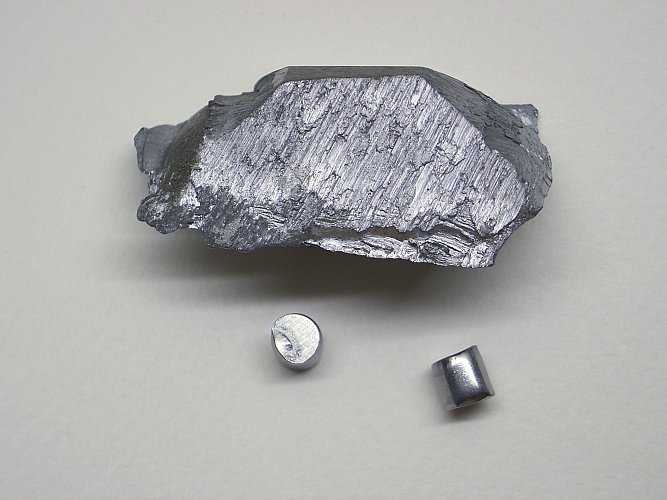


Vanadium
 Vanadium is a silvery metal
with a bluish hue, which, when in the pure
state is comparatively corrosion resistant. Only concentrated hot acids are
capable of attacking this metal at an appreciable rate. This is due to formation
of a protective oxide layer, which only very slowly dissolves in acids. Strong
alkalies do not attack the metal.
Vanadium is a silvery metal
with a bluish hue, which, when in the pure
state is comparatively corrosion resistant. Only concentrated hot acids are
capable of attacking this metal at an appreciable rate. This is due to formation
of a protective oxide layer, which only very slowly dissolves in acids. Strong
alkalies do not attack the metal.
Elementary vanadium can be purchased very frequently on eBay, but it is remarkably expensive with a price tag of a few dollars per gram. This high price is due to the difficulty of producing pure vanadium metal. In its ordinary application it hardly is used in the pure form, it usually is alloyed with iron for making wear-resistant and strong steel.
Although metallic vanadium might be interesting for the home lab, its high price makes it less attractive. Fortunately a very cheap and easy to obtain compound of vanadium is available for the public.
![]()
Vanadium can have the +2, +3, +4 and +5 oxidation state in its compounds. These compounds are remarkably colorful. The name 'vanadium' is derived from the word 'vanadis', which is the old name for a Nordic goddess of beauty. In fact, with simple vanadium compounds, all colors from the rainbow can be obtained. Some of the colors are demonstrated here by means of a simple experiment. When peroxo-complexes of vanadium are added to the 'game', then all kinds of reds and browns can be added to the spectrum of colors.
![]() For
the public, the compound vanadium pentoxide, V2O5, is
available at pottery and ceramics shops at low cost. This is a yellow/brown
powder, which is sparingly soluble in water. It can be dissolved in an alkaline
solution with just a little heating. If the powder is bright yellow, then it is
fairly pure and clear colorless solutions can be prepared with this. Sometimes,
the powder is more brownish with a grey tinge. If that is the case, then there
may be quite some ammonium metavanadate (NH4VO3) in the
powder. For the experiments, described on this site, the presence of this
impurity is of no concern.
For
the public, the compound vanadium pentoxide, V2O5, is
available at pottery and ceramics shops at low cost. This is a yellow/brown
powder, which is sparingly soluble in water. It can be dissolved in an alkaline
solution with just a little heating. If the powder is bright yellow, then it is
fairly pure and clear colorless solutions can be prepared with this. Sometimes,
the powder is more brownish with a grey tinge. If that is the case, then there
may be quite some ammonium metavanadate (NH4VO3) in the
powder. For the experiments, described on this site, the presence of this
impurity is of no concern.
With vanadium pentoxide at hand, one can make other vanadium compounds easily. First, the compound needs to be dissolved in a solution of sodium hydroxide. This requires some heating. The solution obtained in this way is colorless or pale yellow. If the vanadium pentoxide contains quite some ammonium metavanadate, then a grayish solid may be formed, when it is dissolved in a solution of sodium hydroxide. This grayish flocculent solid can be discarded, after it has settled at the bottom.
The colorless solution which remains can be acidified to form pervanadyl, VO2+, compounds of vanadium in the +5 oxidation state, which are yellow. With some sodium metabisulfite, the yellow acidic pervanadyl can easily be converted to blue vanadyl, VO2+. By boiling the liquid gently for a while, any excess sulphur dioxide from the acidified sulfite or metabisulfite can be driven off. The yellow and blue liquids can be stored and can be used as a starting point for many other interesting experiments with vanadium compounds.
![]() Vanadyl sulfate, VOSO4·xH2O, also is available for the
general public. It can be ordered at some photography raw chemical suppliers as
a special order for toning purposes. This compound, like vanadium metal, is
quite expensive, at a price tag of approximately $1 per gram. This salt is
deliquescent. It is a blue moist solid, which can be dissolved in water fairly
easily. For the home lab, this salt does not add very much, when vanadium
pentoxide is available.
Vanadyl sulfate, VOSO4·xH2O, also is available for the
general public. It can be ordered at some photography raw chemical suppliers as
a special order for toning purposes. This compound, like vanadium metal, is
quite expensive, at a price tag of approximately $1 per gram. This salt is
deliquescent. It is a blue moist solid, which can be dissolved in water fairly
easily. For the home lab, this salt does not add very much, when vanadium
pentoxide is available.

![]() Compounds of
vanadium are toxic. When experiments are conducted with vanadium pentoxide or
solutions prepared with this, be sure not to breathe any fine particles or
droplets of the (boiling) solutions. Vanadium waste definitely must be brought
to a proper waste processing facility.
Compounds of
vanadium are toxic. When experiments are conducted with vanadium pentoxide or
solutions prepared with this, be sure not to breathe any fine particles or
droplets of the (boiling) solutions. Vanadium waste definitely must be brought
to a proper waste processing facility.